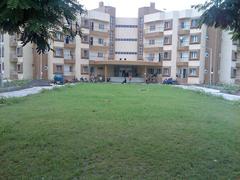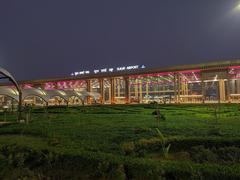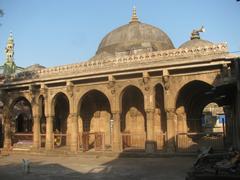Dutch and Armenian Cemetery Surat: Visiting Hours, Tickets, and Historical Significance
Date: 14/06/2025
Introduction
Surat, a thriving port city on India’s western coast, is renowned not only for its commercial legacy but also for its diverse cultural tapestry. Among its many historic sites, the Dutch and Armenian Cemeteries stand as enduring reminders of Surat’s role as a cosmopolitan trading hub from the 16th to 18th centuries. These cemeteries—distinct in architecture, layout, and cultural symbolism—offer visitors a rare window into the lives, traditions, and global connections of European and Armenian merchant communities that helped shape Surat’s development (Surat Culture & Heritage, Scroll.in, TravelTriangle).
This guide provides comprehensive information about the history, architectural features, visitor details, and cultural relevance of the Dutch and Armenian Cemeteries in Surat. Whether you are a history enthusiast, a heritage tourist, or a casual traveler, this article will help you plan and enrich your visit to these unique Surat historical sites.
Table of Contents
- History and Cultural Significance
- Dutch Cemetery: Layout and Architecture
- Armenian Cemetery: Layout and Features
- Comparative Analysis
- Visitor Information
- Heritage and Preservation
- Frequently Asked Questions (FAQ)
- Conclusion and Travel Tips
- Official Sources and Further Reading
History and Cultural Significance
Early Settlement and Mercantile Rise
Surat’s strategic port on the Arabian Sea attracted traders from Persia, Europe, and beyond. Armenians, among the earliest foreign communities, were active in Surat from the 14th century, with their numbers and influence rising notably during the 16th and 17th centuries (Chinarmart). The Dutch and British followed in the early 17th century, establishing trading posts and leaving legacies of commercial and architectural rivalry (Surat Culture & Heritage).
Armenian Community
The Armenian enclave built churches, established a mortuary chapel (1695), and left behind nearly 200 gravestones inscribed in Armenian. These records provide rare insights into their customs, language, and religious life (Scroll.in). The oldest extant gravestone dates to 1579 CE, marking the burial of Marinas, wife of an Armenian priest.
The Armenian population declined in the 18th century as trade shifted to Bombay, Madras, and Calcutta. By 1820, the community had all but vanished from Surat, leaving the cemetery and chapel as the main physical evidence of their presence.
Dutch and British Influence
The Dutch East India Company established its Surat factory in 1616, constructing imposing mausoleums and tombs for its officials and merchants. The Dutch and British cemeteries reflect their respective power and ambitions, incorporating both European and Indo-Islamic architectural motifs (Shared Cemeteries Network).
Dutch Cemetery: Layout and Architecture
Location and Spatial Organization
Located near Katargam Darwaja in Gulam Falia, the Dutch Cemetery is characterized by an asymmetrical layout, reflecting organic growth rather than strict European planning (Shared Cemeteries Network).
Key Architectural Features
- Monumental Mausoleums: The most notable is the tomb of Baron Adrian Van Reede, with a double cupola, galleries, and remnants of mural paintings and wood carvings (Navrang India).
- Materials and Craftsmanship: Constructed from local brick, stone, and stucco, the Dutch mausoleums blend European funerary forms with domes, arches, and chhatris—hallmarks of Indo-Islamic style (OurVadodara).
- Other Tombs: Commemorate officials such as de Roo and include inscribed tablets for Dutch women like Magdalene Haijers and Bastina Theodora Le Boucq.
Conservation
Despite ASI protection, the Dutch Cemetery faces threats from urban encroachment, weathering, and limited maintenance. Conservation efforts are ongoing but require increased public support (Shared Cemeteries Network).
Armenian Cemetery: Layout and Features
General Layout and Structures
The Armenian Cemetery, adjacent to the Dutch section, is marked by simplicity and humility. Its graves are arranged in regular rows with flat stone slabs, mostly lacking superstructures (OurVadodara).
Mortuary Chapel
The central mortuary chapel, built circa 1695, houses the grave of Kalandar, son of merchant Khoja Phanoos Kalandar. The rectangular, vaulted structure is minimally ornamented, emphasizing spiritual over material grandeur (Navrang India).
Tombstones and Inscriptions
Armenian gravestones bear biblical references and genealogical information in Armenian script, some dating to the late 16th century (Surat Municipal Corporation).
Comparative Analysis
- Scale and Monumentality: The Dutch Cemetery is dominated by large mausoleums; the Armenian Cemetery by modest tombstones and a chapel.
- Architectural Influences: Dutch tombs blend European and Indo-Islamic forms; Armenian graves reflect ecclesiastical traditions and restraint.
- Spatial Organization: Dutch structures are asymmetrical; Armenian graves are in regular rows.
Visitor Information
Location & How to Reach
Both cemeteries are situated near Katargam Darwaja, 6 km from Surat Railway Station and about 15 km from Surat International Airport (TripHobo).
By Car/Taxi: The most convenient mode, with parking available nearby.
By Public Transport: Local buses and auto-rickshaws provide access; ask for “Katargam Dutch Cemetery” or “Armenian Cemetery.”
Opening Hours and Entry
- Hours: Open daily from 9:00 AM to 5:00 PM (some sources mention 7:00 AM to 7:00 PM; check locally for seasonal variations).
- Entry Fee: Free for all visitors; no tickets required.
Facilities and Accessibility
- Restrooms: None onsite; use nearby restaurants or hotels.
- Accessibility: Terrain is uneven and largely unpaved; limited wheelchair access.
- Security: Guards are present during opening hours.
Guided Tours
Local guides can be arranged through Surat-based tour operators or heritage groups, offering additional historical context. Informational plaques are limited, so consider preparing in advance (TripHobo).
Photography
Photography is allowed for personal use. For professional shoots, check with onsite security for permissions.
Etiquette
- Be respectful and avoid loud or disruptive behavior.
- Dress modestly.
- Do not climb or touch monuments.
- Take all trash with you.
Nearby Attractions
Combine your visit with other heritage sites such as Surat Castle, the Old Fort, and the Dutch Garden for a comprehensive historical experience.
Heritage and Preservation
The Dutch and Armenian Cemeteries are protected heritage sites, yet they face challenges from urbanization and environmental exposure. Ongoing conservation projects underscore the need for public awareness and responsible tourism to ensure the survival of these irreplaceable cultural landmarks (TravelTriangle).
Frequently Asked Questions (FAQ)
Q: What are the visiting hours?
A: Generally, 9:00 AM to 5:00 PM daily; some sources mention 7:00 AM to 7:00 PM.
Q: Is there an entry fee or are tickets needed?
A: Entry is free; no tickets are required.
Q: Are guided tours available?
A: Yes, through local heritage groups or tour operators.
Q: Is photography allowed?
A: Yes, for personal use. For professional shoots, seek permission.
Q: Are the cemeteries wheelchair accessible?
A: Limited accessibility due to uneven terrain.
Q: What are nearby attractions?
A: Surat Castle, the Old Fort, Dutch Garden, and local markets.
Conclusion and Travel Tips
The Dutch and Armenian Cemeteries in Surat are vital sites for understanding the city’s multilayered history and cosmopolitan identity. Their unique blend of architecture, inscriptions, and cultural memories makes them essential stops for heritage travelers. Visit during the cooler months for comfort, consider engaging a local guide, and respect the sanctity of these spaces to help preserve them for future generations.
For more details, download the Audiala app or consult official Surat tourism resources.
Official Sources and Further Reading
- Surat Culture & Heritage
- Before Armenians flourished in Bombay and Calcutta, they found a thriving home in Surat – Scroll.in
- The 16th-17th Centuries Armenian Gravestones: A Testament to the Armenian Presence in Surat, India – Chinarmart
- Thesis on the Dutch Cemetery in Surat, India – Shared Cemeteries Network
- Historical Places in Surat – TravelTriangle
- Dutch Cemetery, Surat – TripHobo
- The English, Dutch, and Armenian Cemeteries of Surat: Enigmatic Remnants of Colonialism – OurVadodara
- Armenian Cemetery of Surat, Gujarat – Navrang India
- Surat Municipal Corporation: Cemeteries


